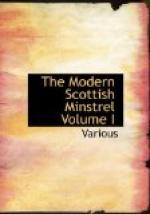[38] These two stanzas were written as a continuation of Burns’s popular song, “Of a’ the airts the wind can blaw.” Two other stanzas were added by John Hamilton. See ante, p. 124.
ALEXANDER CAMPBELL.
A miscellaneous writer, a poet, and a musical composer, Alexander Campbell first saw the light at Tombea, on the banks of Loch Lubnaig, in Perthshire. He was born in 1764, and received such education as his parents could afford him, which was not very ample, at the parish school of Callander. An early taste for music induced him to proceed to Edinburgh, there to cultivate a systematic acquaintance with the art. Acquiring a knowledge of the science under the celebrated Tenducci and others, he became himself a teacher of the harpsichord and of vocal music, in the metropolis. As an upholder of Jacobitism, when it was scarcely to be dreaded as a political offence, he officiated as organist in a non-juring chapel in the vicinity of Nicolson Street; and while so employed had the good fortune to form the acquaintance of Burns, who was pleased to discover in an individual entertaining similar state sentiments with himself, an enthusiastic devotion to national melody and song.
Mr Campbell was twice married; his second wife was the widow of a Highland gentleman, and he was induced to hope that his condition might thus be permanently improved. He therefore relinquished his original vocation, and commenced the study of physic, with the view of obtaining an appointment as surgeon in the public service; but his sanguine hopes proved abortive, and, to complete his mortification, his wife left him in Edinburgh, and sought a retreat in the Highlands. He again procured some employment as a teacher of music; and about the year 1810, one of his expedients was to give lessons in drawing. He was a man of a fervent spirit, and possessed of talents, which, if they had been adequately cultivated, and more concentrated, might have enabled him to attain considerable distinction; but, apparently aiming at the reputation of universal genius, he alternately cultivated the study of music, poetry, painting, and physic. At a more recent period, Sir Walter Scott found him occasional employment in transcribing manuscripts; and during the unhappy remainder of his life he had to struggle with many difficulties.
One of his publications bears the title of “Odes and Miscellaneous Poems, by a Student of Medicine in the University of Edinburgh,” Edinburgh, 1790, 4to. These lucubrations, which attracted no share of public attention, were followed by “The Guinea Note, a Poem, by Timothy Twig, Esquire,” Edinburgh, 1797, 4to. His next work is entitled, “An Introduction to the History of Poetry in Scotland, with Illustrations by David Allan,” Edinburgh, 1798, 4to. This work, though written in a rambling style, contains a small proportion of useful materials very unskilfully digested. “A




